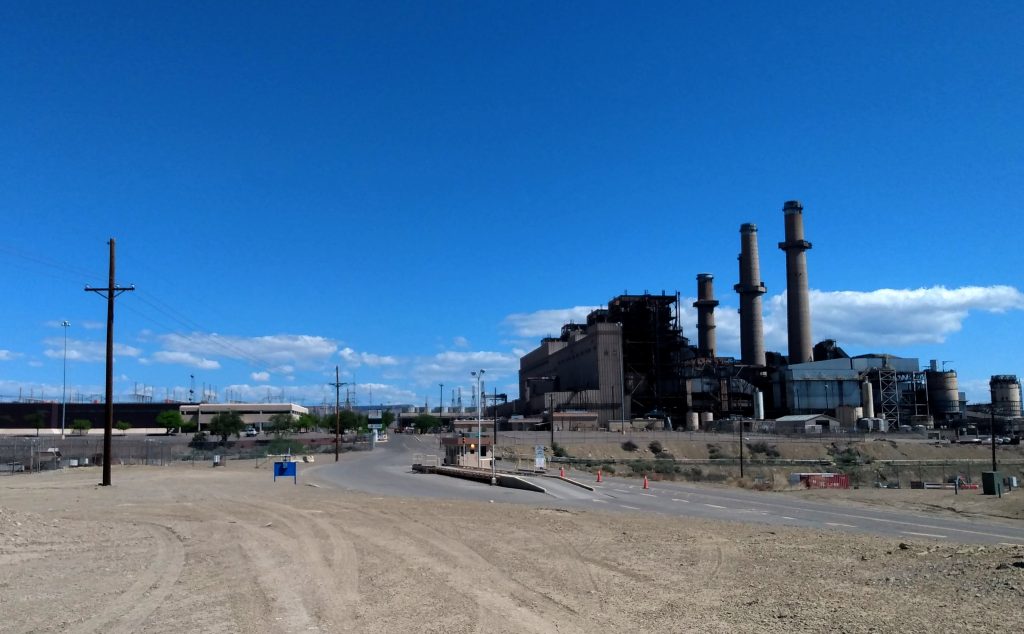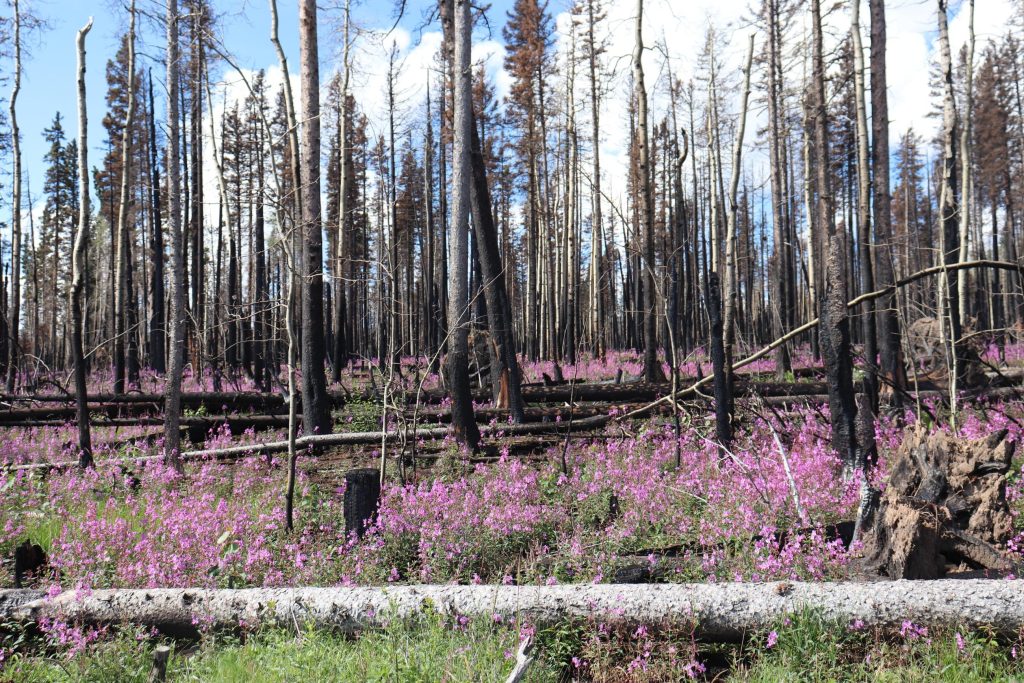Land home packages.
$500 down, $375 per month.
Call now!
Beyond these roadside signs, Chaparral appears as a few rows of mobile homes in a flat expanse of scrubland. But at night, when the stars come out over the desert and Chaparral is as dark as “the wolf’s mouth,” as one woman put it, it’s quickly apparent that the homes extend all the way to the horizon, dotting the landscape with a faint glow every few hundred feet.
Chaparral is New Mexico’s largest colonia, one of the many unincorporated communities in the U.S.-Mexico borderlands, all characterized by high rates of poverty and lack of access to basic public services. It is only 10 minutes past the furthest northeastern reaches of El Paso, but it feels a galaxy away from the city’s nearby suburbs, with their two-car driveways and faux-stucco houses.
This story originally appeared at Searchlight New Mexico and is republished with permission.
The only major employers in Chaparral are the prison and the immigration detention center on the town’s northern outskirts. Both are owned by Otero County and run by a private company, Management and Training Corporation. When Chaparral is in the news, it is usually because of the Otero County Processing Center, which holds detainees on behalf of Immigration and Customs Enforcement.
Over the years, everyone from the ACLU to ICE’s own inspector general has documented a litany of problems at the facility, from the use of solitary confinement as a punishment for detainees with mental illness to substandard food and healthcare. In recent months, detainees have mounted hunger strikes to protest their prolonged detention. In October, several threatened suicide, saying they couldn’t tolerate the conditions any longer. Last month, a French detainee was admitted to a hospital in Albuquerque with symptoms of emaciation and possible sepsis shortly after being transferred out of Otero; he died Dec. 29.
But here in Chaparral, the news from Otero rarely makes waves. Almost no one in the community works at the detention center — perhaps because so many of Chaparral’s residents are undocumented, or have undocumented family members.
That much is obvious in the early morning hours, when lines of cars snake out of town, headed toward the factories, construction sites and fast food restaurants of El Paso and Las Cruces. Moving in the other direction are cars from El Paso and Las Cruces, their drivers headed for shifts at Otero.
Liminal spaces
When Sofia (whose name has been changed) moved to Chaparral in 2002, the detention center didn’t even exist. Sofia grew up in Zacatecas, in central Mexico, but moved to the United States when she was 18, to take care of a niece. She soon met her husband, Carlos, also undocumented, and together they bought a piece of land and a trailer in Chaparral. Their house was close to their extended family, and more importantly, it represented an investment in their future in America.
At the time, Chaparral was half the size it is today, but still one of the larger of the 150 or so colonias in New Mexico. And it was growing rapidly.
Land and mobile homes here are cheap — most of them bought and sold through real estate contracts instead of mortgages, with buyers paying developers directly, often in monthly installments. It is an arrangement that typically doesn’t require proof of citizenship, a good credit history or much of a down payment.
On the flip side, it often comes with exorbitant interest rates and none of the protections of a mortgage. In such dealings, the power lies entirely with the seller, who has the right to repossess a property after a single missed payment — without refunding any of the money already paid. Practically speaking, this means the homeowner could make payments for a decade, miss a single month, and lose everything he or she has invested.
This is not just a hypothetical — it’s a well-documented practice in colonias across New Mexico.
For Sofia and Carlos, buying land that way was never an option. “You can never pay it off,” she says. Instead, they bought their land from a neighbor, who asked for a modest down payment and monthly installments. After a few years, they owned it outright: their very own slice of America.
But for Sofia and Carlos, America is and always has been a very small place, one demarcated by six Border Patrol checkpoints, beginning and ending east of El Paso, south of Alamogordo and west of Las Cruces. Passing through these checkpoints as an undocumented person was a risk Sofia never intended to take.
Not until March 2019.
That’s when she started hearing rumors that the checkpoints had been closed. It happened when the Border Patrol became overwhelmed by the number of Central American refugees arriving every day and decided to shift agents from the interior checkpoints to the border itself. Photos started trickling in on Facebook, as friends and neighbors from Chaparral began tagging themselves in California and Colorado.
One woman raved about the greenery beyond the checkpoints. “I fell in love with all these states because they’re so green,” said Veronica — not her real name — who went to California with her family during the closure. “California is beautiful, the ocean was so beautiful.”
Back in Chaparral, she felt like “a bird in a cage.”
Sofia wasn’t so eager to escape. When a relative suggested that she, Carlos and their three children — who are U.S. citizens by virtue of being born here — join him on a trip to Phoenix, she wavered. She had heard that Arizona was full of racists. She worried about the expense. While Carlos had steady work, they were saving up for their eldest daughter’s quinceañera and an engagement party for Sofia’s brother.
Most significantly, there was the risk. Sofia wasn’t convinced the checkpoints were really closed. She had been living in Chaparral for almost two decades, and they had never been closed before — at least not as far as she knew. But the relative, who is a citizen, offered to pay for the hotel and a rental car. He promised that he would go through the checkpoint first, to make sure it was closed.
So one late spring morning in 2019, Sofia and Carlos and their kids piled into the car and headed west. As promised, the relative went through the checkpoint first, and called to let them know that it was indeed closed. Now it was their turn.
“It was like my heart was trying to jump out of my chest,” she said. Carlos was nervous too. As they approached the checkpoint, he told everyone in the car to stop talking, paranoid that the unmanned checkpoint would somehow discern their immigration status. Soon, though, the orange cones that the Border Patrol had set up to block the checkpoint entrance faded in the rearview mirror, and Sofia picked up her phone. She called everyone she knew; it was dizzyingly exciting.
After two decades of never traveling further than the 35 miles to Las Cruces, Sofia and her family were together on the open road, bound for Phoenix.
Upon arriving, she found the city bewildering. “It’s a desert, isn’t it?” she said. “But everything was so green. There were all these orange trees, at the hotel and in front of everyone’s houses. How is it possible?”
In Chaparral, the desert is inescapable. When the wind blows, it picks up dust from the dirt roads and sends it swirling into a smudgy brown cloud that envelops everything. Tumbleweeds roll through town, getting caught on the chain link fences, on prickly pear cactus and agave plants.
Chaparral is a place that exists almost off the map, which is part of its appeal for many of its 15,000 — or possibly 25,000 — residents. (The official U.S. Census count is notoriously low.)
Guillermina Núñez-Mchiri, an anthropologist at the University of Texas at El Paso who studies colonias, described them as “liminal spaces” that are “out of sight and out of mind” for most Americans.
“Not much attention is brought to you, but because there isn’t a lot of attention, there’s also the flip side,” she said. “There are costs to those gray spaces.”
In Chaparral, those costs are visible wherever you look — in the lack of sidewalks and the absence of street lights. They manifest in the high rate of teen pregnancies and a median household income of $24,900, about 40 percent of the nation as a whole.
In an unincorporated community, there is no local government — no mayor, no city council, no police department, no sanitation services, no public library. The colonia is divided almost exactly down the middle into two separate counties — Doña Ana to the west, and Otero to the east — each of which maintains a sheriff’s office and a volunteer fire station.
Doña Ana recently started building a sewer system, to reduce the community’s reliance on septic tanks, but it only reaches a fraction of households. In 2006, there was a vote on whether to incorporate Chaparral, which would have given residents more control over management of the town, but it failed. People were afraid of higher taxes and more government oversight.
“The fact is that in our region, there is not a lot of work — well-paid work,” said Sister Chabela Galbe, a nun who helps run the Assumption Sisters convent, which focuses on social justice issues. “We are mice in a mouse trap. But poor or not poor, [Chaparral is] rich in humanity and solidarity.”
There is, for example, the grandmother who moved from California after a lifetime of farm labor because in Chaparral she could afford her own home and land. There is the internet cafe owner who grew up in town and always dreamed of leaving, but instead started a business that turned six figures in sales last year. There is the youth group at the Catholic church that goes door to door every Thanksgiving to deliver turkeys to families in need. There are the nuns who organized the community to provide food and shelter for the refugees arriving from Central America.
“You can count always with the community to support each other,” Galbe said. “Very, very, very generous and in solidaridad siempre.”
For all the insecurities of life in Chaparral, the security of family and community can be relied on.
Other Americans
At the hotel in Phoenix, Chaparral seemed impossibly far away. There was a swimming pool and waterfalls, and — unlike back home — an overwhelming number of white people. “Americans,” as Sofia called them. She felt like she didn’t belong; more than that, she felt like everyone could see that she and Carlos didn’t belong.
On their first morning, the two went to find coffee. As they searched for the hotel restaurant, everyone they passed appeared to be dressed for a run or a yoga class. Sofia and Carlos were dressed “basically in heels” — clothing that had seemed appropriate for such a fancy place.
“I was so embarrassed,” Sofia said. “I told Carlos, let’s go back to the room.”
Phoenix was a different world, far from the America she knew.
“We know what’s outside now,” Sofia said.
Good deals all around
The first records of settlement in the Chaparral area date back to the turn of the 20th century, when the federal government started giving away large plots of land to homesteaders. But its present development can be largely attributed to a single family: the Colquitts.
In the 1950s, Prescott Kellum (P.K.) Colquitt purchased 1,600 acres of land from his stepfather, A.D. Greenwood, for $15,000 (the equivalent of about $150,000 in 2019). For a while, he ran cattle on the property, but then in the 1960s, around the time when many colonias started to develop, P.K. and his son, John B. Colquitt, formed a real estate company and started subdividing the land. What started as a few dozen lots with mobile homes grew rapidly into a small city, albeit one without any of the trappings of a city.
The new residents proved to be good business for the Colquitts, and not just in the realm of real estate. Today, the family runs Chaparral’s water company, Lake Section Water, and owns the local cemetery.
Now 80, John Colquitt still works out of his office in Chaparral. He has white hair and watery eyes, and is known to wear button-down shirts with his initials monogrammed on the cuffs. Around town, he has the reputation of a beneficent patron, someone who reliably donates to the Christmas food drive and the Catholic church, even though he himself is not Catholic.
One person referred to him as the unofficial mayor; another called him the town’s father. As an example of his humility, several people shared a story about the time Colquitt attended a party for one of his longtime employees. “Such a good man,” one woman remarked, recalling the occasion.
Colquitt himself describes Chaparral as a community “made up of people who want a little more space,” but although he has made his living selling land to immigrants, he is also a staunch defender of the immigration detention center at Otero. He is the community liaison to the facility and has appeared in marketing materials for MTC, the company that runs Otero, which can house up to 1,000 immigrant detainees at a time.
“It’s been financially a very good deal for Otero County,” he said, in reference to the revenue the county receives from the federal government for each detainee.
It has also been a good deal for John Colquitt, who sold the land to Otero County to build the detention center back in 2002, and continues to supply the facility with water.
Colquitt maintains that Chaparral does not have and has never had a large undocumented population — a view that runs counter to widely held opinion.
The old normal
By the end of last summer, Sofia’s America had returned to its usual size. The checkpoints reopened after several months, and she and Carlos had begun renovating a second trailer that they purchased along with a parcel of land.
“It’s sort of an investment,” Sofia said.
Veronica, the woman who fell in love with the outside world, was less sanguine about her future. After four days in California, she returned to Chaparral and to her job as a prep chef. During her long hours alone, chopping meat and vegetables, she found herself daydreaming about all the places she would like to visit, getting so lost in her thoughts that more than once she sliced her fingers open — bringing her back to reality, to Chaparral, to home.
Stephanie May Joyce is a freelance writer who reports and produces stories in audio and print from Santa Fe, NM. She’s covered wildfires, border conflicts, commercial fishing and the coal industry for publications like NPR, Outside, 99% Invisible and Bloomberg Businessweek. Previously she was an editor and producer for WNYC Studios, and started her career working at public radio stations in Wyoming and Alaska.






















